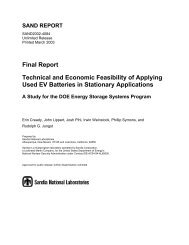Fleet Electrification Roadmap
Fleet Electrification Roadmap
Fleet Electrification Roadmap
- No tags were found...
You also want an ePaper? Increase the reach of your titles
YUMPU automatically turns print PDFs into web optimized ePapers that Google loves.
34 primer: electrification of the transportation sectorspecial sectionspecial sectionfleet electrification roadmap 35The Advantages of Electric DriveFIGURE P17Vehicle Emissions by Technology and FuelElectric drive technology offers a significant improvementin efficiency within a given vehicle class when comparedto a comparable traditional internal combustionengine vehicle. In large part, this is due to the high efficiencyof electric motors, which can convert as much as80 to 90 percent of the energy content of electricity intomechanical energy. This efficiency contributes to severalsignificant benefits for the vehicle operator.Reduced Fuel Costs: Electric drive offers significantreductions in fuel costs on a per-mile basis. Withgasoline at $3.00 per gallon, a relatively efficient internalcombustion engine vehicle rated at 30 miles per gallonhas an average fuel cost of 10 cents per mile. A mid-sizedsport utility vehicle getting 20 miles per gallon has anaverage fuel cost of 15 cents per mile, and a medium-dutyurban delivery vehicle getting 10 miles per gallon has anaverage fuel cost of 30 cents per mile. Comparatively, alight-duty battery electric vehicle or a PHEV in chargedepletingmode would have fuel costs of just 2.5 cents permile, assuming electricity priced at 10 cents per kilowatthour (kWh) and an electric motor efficiency of 4 miles perkWh. At 2.0 miles per kWh, the fuel cost for a mediumdutyPHEV or EV truck would be 5 cents per mile.Efficient Use of Energy: Low fuel costs for EVs andPHEVs are partially a function of the low price of electricityon an energy-equivalent basis. They are also a functionof the efficiency of electric motors. However, all electricdrive technologies also make efficient use of energy fromthe point of combustion. For EVs and PHEVs, assessingthat efficiency requires moving up the energy system tothe point where fuel is combusted in a power plant. Usingthis measure, the efficiency advantage of electric drive isFIGURE P16Relative Efficiency of Sample Light-Duty Vehicle Technologies0.5 Miles traveled per 1,000 BTU0.40.30.20.10.0EVFull Hybridreadily apparent. A traditional ICE vehicle getting 30 mpgcan travel less than one-fourth of a mile on the energycontained in 1,000 Btu of gasoline. An electric vehicle orPHEV in charge-depleting mode can travel nearly doublethat distance on 1,000 Btu of natural gas used to generateelectricity, even accounting for line losses in transmittingthe electricity from the power plant.Reduced Emissions: Electric drive technology canprovide significant reductions in CO 2 emissions comparedto conventional vehicles powered by fossil fuels. Today’sfull hybrids offer as much as a 30 percent improvement inemissions when compared to similarly sized conventionalgasoline vehicles. Questions have been raised about theemissions profile of PHEVs and EVs, because approximately48 percent of current U.S. electricity generationis derived from coal-fired power plants. 58 Together withnatural gas, fossil fuels account for as much as 70 percentof U.S. power generation. 59However, the emissions benefits of electric drivevehicles are still significant. A number of well-to-wheelsanalyses have quantified emissions benefits of electricdrive technology in recent years. One study from theNatural Resources Defense Council and the Electric PowerResearch Institute found that a PHEV-20 powered by electricityfrom the grid offered significant emissions benefits,even if 100 percent of the electricity used to power thevehicle was generated at a relatively inefficient coal plant. 6058 DOE, AER 2009, Table 8.2a.59 Id.60 Electric Power Research Institute (EPRI), Natural Resources DefenseCouncil & Charles Clark Group, Environmental Assessment of Plug-In HybridElectric Vehicles: Volume 1: Nationwide Greenhouse Gas Emissions (2007).Natural Gas VehicleTraditional ICEFuel Cost per Mile ($) 0.120.100.080.060.040.020.00Gasoline Well-to-TankGasoline Tank-to-WheelsPHEV - RenewablesSource: Electric Power Research Institute; Natural Resources Defense CouncilAnd in fact, despite the prominent role that coal-firedelectricity generation plays in the U.S. power portfolio,the notion of a PHEV or EV powered 100 percent by coalis somewhat misleading. This is because vehicles plugginginto the grid will be powered by the lowest-cost source ofdispatchable power generation at a given point in time.More often than not, the marginal fuel is unlikely to becoal, as coal typically serves as a source of baseload power,and ramping coal generation requires some measure ofplanning. Instead, the marginal fuel powering PHEVsand EVs is likely to be natural gas in much of the UnitedStates. 61 Natural gas is low cost and easily dispatchable.As a fuel, natural gas contains about 30 percent lessCO 2 than oil and 45 percent less than coal on an energyequivalent basis. 62 Moreover, the platform in whichthe fuel is consumed impacts emissions significantly.On average, the fleet of U.S. coal power plants currentlyhas a 32 percent efficiency rating. 63 In contrast, the currentnatural gas-fueled power fleet reaches roughly43 percent, and it has been improving substantially ascombined cycle gas plants are deployed in greater numbers.64 Current-generation combined cycle plants reachefficiency levels of 60 percent, 65 which, when combined61 Oak Ridge National Laboratory (ORNL), Potential Impacts of Plug-inHybrid Electric Vehicles on Regional Power Generation (2008), availableat http://apps.ornl.gov/~pts/prod/pubs/ldoc7922_regional_phev_analysis.pdf.62 DOE, EIA, Natural Gas Issues and Trends, at 58 (Table 2) (1999).63 János M.Beér, “Higher Efficiency Power Generation Reduces Emissions:National Coal Council Issue Paper, at 2 (2009).64 DOE, EIA, Electric Power Annual 2009 (EPA 2009), Average OperatingHeat Rate for Selected Energy Sources, available at http://www.eia.doe.gov/cneaf/electricity/epa/epat5p3.html.65 GE Energy, “Gas Turbine and Combined Cycle Products,” at 4, available atwww.gepower.com/prod_serv/products/gas_turbines_cc/en/downloads/gasturbine_cc_products.pdf, last accessed on August 28, 2009.PHEV - 2010 Old CCElectricity Well-to-Wheels0 100 200 300 400HEVPHEV- 2010 Old GTPHEV - 2010 Old CoalConventional VehicleGrams of CO 2 per Milewith the lower carbon profile of gas, results in an emissionsreduction of about 70 percent per unit of electricitygenerated versus the existing coal fleet. 66One recent study from the Oak Ridge NationalLaboratory simulated the impact of significant adoption ofPHEVs throughout the United States. 67 The study assumedthat more than 19 million PHEVs would be on the road by2020, and it plotted penetration across different NationalElectricity Reliability Council (NERC) regions. Aggregatedacross all NERC regions, the study found that natural gas generationprovided for the bulk of added electricity generationneeded to power PHEVs in a variety of charging scenarios.Most recently, Argonne National Laboratory simulatedthe well-to-wheels emissions profile of a number ofPHEVs with varying battery sizes in different regions ofthe United States. 68 The analysis found that a PHEV-40in charge-depleting (CD) mode had significantly lowerCO 2 emissions than a conventional gasoline vehicle ineach region analyzed, and in most cases the PHEV-40 inCD mode outperformed a traditional HEV. In Illinois, acoal-dominated region, the PHEV still offered an emissionimprovement over a conventional gasoline vehicle, whileHEVs performed the best out of the technologies evaluated.(The drive cycle used in the Argonne analysis resulted in a 51percent utility factor for a PHEV-40, which is conservative).Energy Security: Electric drive systems representa substantial improvement from an energy security66 Authors’ calculations assuming natural gas contains 45 percent lesscarbon than coal, and comparing a combined cycle gas turbine (60percent efficiency) to the existing coal fleet (32 percent efficiency).67 ORNL, Potential Impacts of Plug-in Hybrid Electric Vehicles on RegionalPower Generation (2008).68 Argonne National Laboratory, Well to Wheels Analysis of Energy Use andGreenhouse Gas Emissions in Plug-in Hybrid Electric Vehicles (2010).Notes: 1. EV efficiecny assumes electricity generated from natural gas at the U.S. national average heat rate of 8,305 Btu/kWh; 10 percent line loss; and motor efficiency of 4.0 mi/kWh2. Full hybird mpg assumed at 50 3. ICE mpg assumed at 30 4. NGV mpg-e assumed at 28 5. Gaoline assumed at $3/gal; CNG at $1.50 GGE; electricity at $0.10/kWh.
















